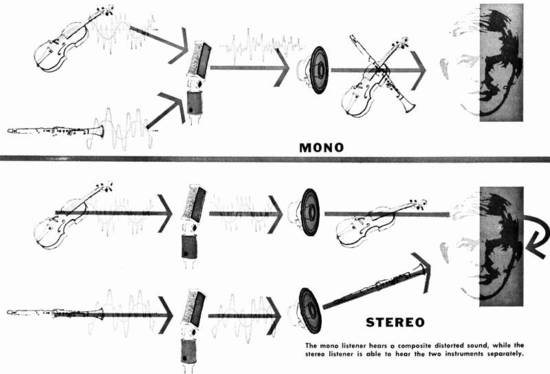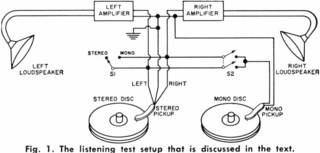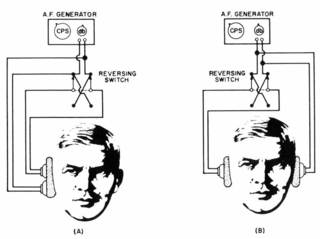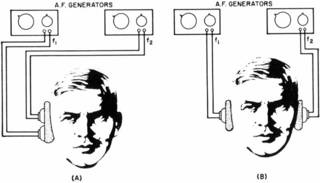Ein RCA Bericht über die Mono Probleme mit Stereo Aufnahmen
Was ist an diesem Labor-Bericht aus 1962 so besonderes zu finden ? Dazu benötigen wir etwas Abstand von 30 oder 40 Jahren und dann gehen uns die Augen auf. Als 1983 die CD auf den Markt kam und die ersten super tollen CDs zu kaufen waren, ging ein Gegrummel durch die Reihen der Hifi-Gourmets, das klänge aber alles sehr komisch steril und überakkurat und klinisch rein wie Meister Propper. Und richtig, die Tonmeister mußten dazulernen, daß die alte analoge Aufnahmetechnik für Vinylplatten bei den CDs nicht korrekt funktionierte. Und es wurde geändert. Heutige CDs sind den analogen Platten trotz aller Dementis der Analog-Fraktion deutlich überlegen.
Fast genauso war es, als 1958 die ersten Stereo LPs auf den Markt kamen. Alle Tonmeister gaben sich richtige Mühe, mehr als nur den Ping-Pong Effekt zu präsentieren. Dennoch gab es eine Menge Kritik aus den Reihen der alten Kundschaft mit älteren Geräten, in Mono klänge das alles schauderhaft, teilweise sogar verzerrt und dünn, also nicht zum Anhören. Der Laie würde das vielleicht erstmal abwiegeln und auf die alten Abspiel-Anlagen schieben. Doch auch da war etwas Wahres dran. Die Menge der Auslöschungen einer 33er Stereoplatte mit einem Mono-Verstärker abgespielt, war erstaunlich.
So wurde weltweit untersucht und "geforscht", woran denn das nun liegen könnte. So auch mit großem Aufwand in den berühmten RCA Laboratorien von Princeton. RCA war nämlich ein ganz bedeutender Schallplattenanbieter, ein Label.
.
RADIO CORPORATION OF AMERICA
RCA LABORATORIES
Dieser Artikel wurde nachgedruckt - REPRINTED FROM Electronics World October, 1962 by Ziff-Davis Publishing Company.
Die RCA Laboartorien in Princeton unweit der Princeton Universität waren die so ziemlich renomiertesten Labors im Bereich Audio-Elektronik und Audio/Video-Technik.
.
"Non-directional STEREO Effects"
By CHARLES Julian HIRSCH
Corporate Staff for Engineering, Radio Corporation of America
DAVID SARNOFF RESEARCH CENTER PRINCETON, NEW JERSEY
1962 !! - OUR AUTHOR was chairman of Panel 1 of the National Stereophonic Radio Committee, which examined and recommended various systems of stereo broadcasting to the FCC. He was also chairman of the U.S. Department of State delegations to international meetings on color-TV standards. At present, he is chairman of both the EIA Broadcast Television Systems Committee and the IRE Television Systems Committee. Prior to his present position as Administrative Engineer on the Corporate Staff of the Vice-President for Research and Engineering of RCA (with special interest in home instruments), he was Executive Vice-President of Hazeltine Research Corporation.
.
MONO - STEREO
überarbeitet im Juni 2017 von Gert Redlich -
The mono listener hears a composite distorted sound, while the stereo listener is able to hear the two instruments separately.
More of the music is reproduced with less distortion when two channels are employed. Results of simple, easily reproduced experiments and listening tests indicate that stereo reproduction provides reduced cancellation of tones and reverberation effects.
.
Bis vor Kurzem . . . . .
UNTIL very recently, our knowledge of stereophonic reproduction was limited to its directional effects; its non-directional effects were largely unknown, although they are at least of equal importance. The stereo reproduction of music played by a large orchestra is so much richer than the best monophonic reproduction that it appears to be played by an orchestra having a greater number and variety of instruments, which play more completely in tune, in a hall with better reverberation.
This superiority occurs because some of the tones heard on stereo are "annulled" when reproduced monophonically. Stereo is better because it reproduces more of the music with less distortion.
Bis vor kurzer Zeit . . . .
In the recent past, the superiority of stereo was attributed to a mental image which helped to locate each instrument among many, produced a sense of direction to the reverberation, and thereby gave the ambience of being in the concert hall. The term ambiophonic was coined to describe this effect.
While stereo can create such an image, often to good advantage, this explanation is believed to be an incomplete reason for stereo's superiority, which is enjoyed by many music lovers who never go to concerts and who cannot tell one instrument from another.
The superiority of stereo is also evident in large orchestras where the ability to locate instruments by their sound is blurred or even absent.
Music heard in the concert hall, or by stereo, is superior to its mono-phonic reproduction, not because stereo reminds the listener of the concert hall, but because the same desirable effects occur in both cases.
The greater enjoyment provided by the concert hall is not due to technical limitations in the quality of sound reproduction. High-fidelity phonographs can reproduce as wide a gamut of bass, middle, and treble tones, and as high a ratio of fortissimi to pianissimi as the ear can perceive; and they can do so with negligible distortion. Yet lovers of orchestral music prefer stereo, even when its range of tones and intensity are limited, to the best monophonic hi-fi.
Older, more experienced listeners, who cannot hear the highest notes of mono hi-fi, enjoy stereo. Stereo is not necessarily hi-fi, but hi-fi can add to the enjoyment of stereo.
Ungerichtete Effekte = Indirekter Schall
For the purpose of this article, the non-directional effects of stereo are those which are produced in addition to, and independently of, its ability to create a spatial image. These effects are stressed because they have been appreciated and understood only recently. They are largely responsible for the more complete reproduction of all tones and for the superior reproduction of the reverberation in the record. They are desirable for all kinds of music.
Gerichtete Effekte = Direkter Schall
Directional effects are wanted when it is important to know the approximate location of performers on the stage. A spatial image is desirable for operas and plays because it reveals "who is saying, or doing, what to whom".
The location of voices or instruments is important for music that tells a story as, for example, "The Scheherazade Suite" in which each instrument symbolizes a different person. It enhances the pleasure of hearing small orchestras, such as chamber music, especially for people who listen intellectually to discern the structure of the music and to evaluate the virtuosity of the performers.
Nur wer die Oper kennt, hört etwas in Mono
Only those who know an opera or a play well can distinguish one actor or singer from another on a monophonic recording. The monophonic reproduction of a round-table conference or a house party is confusing.
One gets all mixed up when several people talk on a party telephone line; it is almost impossible to tell who is talking. Stereo separates one voice from another by making each appear to come from a different direction.
Stereo hat mehr Informationen und weniger Verzerrungen
Stereo, because of the non-directional effects, reproduces more of the recorded music with less distortion. Notes are heard by stereo which are unheard monophonically. The instruments are more clearly identifiable and the reverberation of the recording studio is superior. The more complete reproduction of musical tones by stereo is especially desirable when listening to large orchestras where the sense of direction is unimportant and often disturbing.
When listening to "absolute" music, the listener often objects to exaggerated directional effects. He may not care if, for example, a violin is at the left or right; and, if the violin reveals its position too blatantly, his attention is diverted from the sheer abstract beauty of the music to the practical mechanism of its creation.
For this reason, some music lovers who have been exposed only to the more spectacular directional effects of stereo, such as ping-pong games, often state that stereo is a musical sacrilege. They are very mistaken!
"Live music" liefert mehr Vergnügen
"Live music" or stereo adds greatly to the pleasure of listeners who are happiest when they feel totally immersed in the pure abstraction of disembodied music, who are unconscious of the instruments, and who don't care where they are. For this kind of music, the fuller reproduction of all tones, the reduced dissonances, and the deeper studio reverberation are provided by the non-directional effects of stereo.
Both the directional and non-directional effects of stereo are caused by the independence of our two ears. Differences in the time, or amplitude, of the reception of a sound by the two ears are interpreted by the brain and produce psychological clues to the location of the source of the sound.
The independence of the two ears from each other prevents the cancellation and interaction of two sounds heard by them individually. The non-directional effects are due to the physiological properties of hearing in a manner to be described later.
Listening Tests
In order to establish in what way stereo reproduction is superior to monophonic reproduction, listening tests were made on a stereophonic phonograph to compare:
- (1) = full stereo - a stereophonic disc reproduced stereophonically,
- (2) = full stereo but shorted to mono - the same disc reproduced monophonically by interconnecting the left and right outputs of the stereo pickup, and
- (3) = full mono - a monophonic disc, reproduced by a monophonic pickup, of the same selection recorded from the same tapes as the stereo disc.
The outputs of all pickups were reproduced by the same music system consisting of two amplifiers and two loudspeakers. Switches allowed the listener to select at will any one of the three forms of reproduction. The test setup is shown in Fig. 1. The selections chosen were symphonies recorded by large, well-known orchestras.
.
Mono und Stereo LPs in Mono abgespielt
Little, if any, difference could be detected between the monophonic disc and the stereophonic disc played mono-phonically; both were excellent.
However, the stereophonic reproduction of the stereophonic disc was so superior to its monophonic reproduction that it seemed to be played by another orchestra. More notes were heard; the bass and recorded reverberation were richer; and the instruments were more clearly identified.
By contrast, the monophonic reproduction seemed to consist of fewer, but more powerful and less readily identifiable instruments. In addition, the monophonic music, although reproduced by two spaced speakers, seemed to come from a hole in front of the listener; while the stereophonic music was spread out over the entire distance between the speakers.
The advantages of stereophony were lost when one ear was closed or when the distance between speakers was greatly reduced, such as by placing one speaker above the other.
Since both the mono and stereo were produced from the same stereo disc, the reduced quality of the mono version must be due to the cancellation of some tones and of the recorded reverberation which are reproduced when the disc is played stereophonically.
Über die Stereo und Mono Wiedergabe beim UKW-Stereo-System
That this might be the case was first suggested by the results obtained from field tests conducted by the National Stereophonic Radio Committee (NSRC), on the broadcasting of stereophonic programs by the FM-multiplex system later adopted by the FCC. (Das entspricht auch unserem deutschen UKW Stereo mit dem 19kHz Pilotton.)
In this system, the signal intended for reception by monophonic receivers consists of the sum (L + R) of the left (L) and right (R) outputs of a stereophonic pickup or of two directional microphones.
For FM stereophonic receivers, a second signal consisting of the difference (L — R) of these outputs is also transmitted. Stereo receivers intercept both signals and can reproduce the original left (L) and right (R) signals in many ways such as by adding and subtracting the transmitted signal as follows: (L + R) + (L - R) = 2L; and (L + R) - (L - R) = 2R.
It was soon found that a sizable number of stereo discs, made in the early days of stereo recordings, gave very poor monophonic reproduction when the outputs of the left and right tracks were added to produce (L + R); the tone was abnormally thin, most of the reverberation was lost, and whole instruments were occasionally missing. Yet the stereo reproduction of the same disc was acceptable.
Investigation revealed that the left and right tracks were recorded accidentally with opposite polarities so that the combined signal became (L — R) instead of (L + R) and tones on the two tracks partly cancelled each other. The error was not discovered earlier because the discs were only tested stereophonically.
Wenn sich Töne auslöschen
The field test suggested that tones which can cancel each other when mixed into a single (L + R) signal do not cancel when heard individually by each ear, as is the case in stereo.
Stereo is freer of these cancellations because the two ears are independent of each other and produce two non-interacting channels directly to the brain. To determine the nature of this independence, experiments made long ago and half forgotten were repeated.
The first experiment is illustrated in Fig. 2. An audiofrequency generator produces a single tone in two earphones.
Bei den Kopfhörern die Polarität vertauschen
The polarity of the input to one earphone can be reversed with respect to the other by a switch. When both earphones are applied to the same ear, as in Fig. 2A, reversing the excitation to one of them causes the intensity heard to increase or decrease as the two polarities are made to add or subtract. When the earphones are applied to separate ears, as in Fig. 2B, the intensity does not change, no matter whether the polarities add or subtract.
The second experiment is shown in Fig. 3. Two audio-frequency generators are connected to individual earphones and their frequencies adjusted to differ by only a few cycles, say 5, from each other. When the two earphones are applied to a single ear, as in Fig. 3A, a strong beat note, whose frequency is equal to the difference in the original frequencies, is heard. When the two earphones are applied to separate ears, as in Fig. 3B, no beat note is heard; instead, there is a sound of constant intensity which travels within the skull between the two ears at a rate equal to the difference-frequency.
Das 3. Experiment
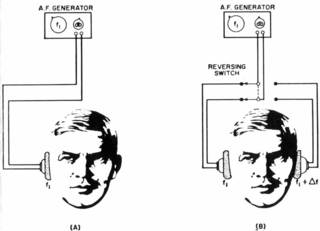
- Fig. 4. The third experiment, which shows that pitch is not the same as excitation frequency. In (A) a constant-frequency signal is applied to one ear. As the intensity is raised, the pitch is lowered. (B) indicates that the pitch perceived by the left ear may be different from that perceived by the right ear, even though the same frequency and intensity are used.
The third experiment is shown in Fig. 4 and produces two results:
- (1) A single note of constant frequency applied to one ear produces a subjective pitch whose apparent frequency depends on the intensity.
- (2) In addition, a single note can produce a subjective pitch in the left ear which is different from the subjective pitch it produces in the right ear even if the intensities are equal. In most cases, this difference amounts to only a few cycles; 0 to 3 to 4 cycles.
In some listeners, one ear produces different harmonics than the other so that true comparison of pitch is not possible. Moreover, the difference in subjective pitch between the two ears does not produce a beat note between them.
Experimental Results
The result of these experiments can be summarized as follows:
- 1. A tone picked up exclusively by one ear does not add or subtract, or modulate, or in any way interfere with the tone picked up exclusively by the other ear except that the two tones give the sensation of traveling between the two ears at the rate of one complete round trip for each phase change of 360 degrees.
- 2. A tone picked up by one ear may produce in some listeners a sensation of pitch which is different from the sensation produced by the same tone in the other ear.
.
Interpretation
The result of these experiments is used to explain why stereo reproduces more of the tones on the record with less distortion and with better reverberation.
Two sine waves of equal frequency and amplitude can only double their intensity when their phases add, but they can completely annul each other when their phases oppose.
When several waves are transmitted over a single channel, the result is the sum of all the instantaneous values of the waves, many of which oppose each other in polarity and tend to cancel.
It does not matter if the single channel is produced by a single electrical path, as when a single microphone is used to pick up disseminated sounds, or when the outputs of several microphones are added to produce a single output; or by a single acoustic path, as when the two speakers are placed close together; or a single aural path as when one ear is closed.
Bei gleichen Instrumenten und gleichem Ton ist die Phase unterschiedlich
The phase with which the sound of identical instruments playing the same note reaches the microphones is random with frequency changes because the phase for each instrument depends on the instant of attack, such as the moment of application of the bow to a string, and obviously two musicians cannot synchronize this instant within the millisecond or less required to reverse the phase of a 500-cyele note.
The phase also depends on the distance of the instrument to the microphone. A difference of path length of only two feet in the distance of two instruments will completely reverse the phase of "middle C" (261.6 cps).
Wenn zwei Instrumente den gleichen Ton spielen
When playing the same note over a single channel, two instruments, such as a violin and a clarinet, may cancel their fundamentals and leave only their overtones.
The result is neither violin or clarinet, but an emaciated composite of the two which sounds like neither, as shown in the drawing on page 41. Since the phase of each instrument varies frequently and randomly, such cancellations are numerous. For a large orchestra this alters the continuous nature of the music.
Ganz anders ist es bei Stereo
In the case of stereo, two identical notes, differing only in phase, so that one is heard mainly by the left ear and the other mainly by the right ear, do not cancel when their phases oppose.
They are heard individually and the relation of the fundamental to the overtones is not disturbed. Thus a violin on the left and a clarinet on the right are clearly heard as individual instruments with their character undisturbed even when they play the same note, no matter what their phase happens to be.
Studio reverberation is preserved more fully by stereophonic reproduction because those sound waves that are reflected out-of-phase from opposite walls reach the ears separately and therefore do not cancel each other.
When one ear receives two notes which differ in frequency, the tones add or crossmodulate each other to produce a beat note whose frequency is equal to the difference in frequency of the originals.
Ein Beispiel
Beat notes of very low frequency are especially rough. For example, let two instruments attempt to play middle C, at 261.6 cps, but let one instrument be outline and play 265.0 cps instead, together they produce a beat whose frequency is 265.0 — 261.6 = 3.4 cps, which is very unpleasant. Discords are unpleasant because they produce such beats.
In the case of stereo, if the two tones (261.6 and 265.0 cps) are heard by the two ears respectively, they are perceived individually as 261.6 and 265.0 cps and do not produce beat notes with each other, even if the difference in their frequencies (3.4 cps) is small.
The fundamental, overtones, and chords heard exclusively by one ear do not interfere with those heard exclusively by the other ear. Therefore, two instruments slightly mistimed, as in the case cited, do not produce unpleasant beats when they are heard by the two ears separately.
As stated previously, a single note may produce a different subjective pitch when heard by one ear than when it is heard by the other. The difference helps further to separate identical notes coming from the left and right. Since the two ears do not cross-modulate, the difference in pitch produces no beat note. The harmony in each ear is consistent with itself and with that in the other ear.
.
Der Grund für den Unterschied in der Tonqualität:
The cause of the difference in the tonal quality of mono-phonic and stereophonic reproduction can be summarized as follows:
In monophonic reproduction all tones occurring simultaneously are added together in a single channel. Pairs of these tones at the same frequency often cancel each other and, when they differ slightly in frequency, produce beats which may be rough and unpleasant.
In stereo the music is divided' into left and right channels that arc applied to the left and right ears respectively. The tones heard predominantly by the left ear cannot cancel or produce beats with those heard predominantly by the right ear.
It is true that all tones heard simultaneously by the left, or right, ear can and do produce the effects just mentioned. However, stereo suffers appreciably fewer annulments of tones and creates appreciably fewer beats. This difference produces the tonal difference between mono and stereo reproduction.
Stated another way, stereophony uses binaural hearing to produce two unrelated effects.
- One effect is psychological; it isolates individual sources of sound from each other by providing clues about their directions from the listener.
- The other effect is physiological; it prevents interference between tones by separating them until they reach the brain.
The spatial image is only incidental when listening to the stereophonic reproduction of orchestral music; although it is essential for the reproduction of operas, theater, parties, and conferences. The directional effect is only a byproduct, and not the cause, of superior orchestral reproduction; it must not be exaggerated into a stunt.
Stereo systems and equipment have, up to now, been evaluated solely for their ability to create a spatial image. This effect is only a part, perhaps the least important, of the contribution stereo makes to the pleasure of listening.
Inferences
The foregoing discussion permits us to make the following inferences:
.
1. Except for greatly enhanced directional effects, there seems to be no reason to use more than two electrical, or acoustic, channels for stereo because we have only two channels from the ears to the brain.
.
- Anmerkung : Das war theoretisch schon in 1962 definitv falsch. Aber "sie" wußten es nicht besser bzw. die Vision fehlte. An Quadro dachte noch keiner. Wie Karl Breh in 1972/1974 herausgefunden hatte, ist eine saubere Quadroaufnahme abgespielt von einem sauberen guten 4-Kanal Quadro-Band eine weitere deutlich wahrnehmbare Steigerung des stereophonen Hör-Erlebnisses sowie des Hörgenusses.
.
2. Binaural reproduction by means of earphones should result in better tonal reproduction than stereo because it results in even fewer cancellations and beats.In the case of stereo, each ear picks up sounds from both loudspeakers to some degree and, to that extent, the reproduction is partly monophonic.
Because the two ears are independent, it should be possible to write special music which would be harmonious when heard binaurally with earphones but which would be discordant, and less fully reproduced, when heard monophonically and, to a lesser degree, stereophonically. However, many people find binaural listening with earphones distracting because the whole orchestra seems to move when the head is turned. In that case the spatial image is actually distracting.
.
3. The tonal (non-directional) improvements of stereo reproduction are maximized when the listener locates himself midway on the line between the two speakers which are made to face each other, because this position, although not critical, results in the maximum binaural separation.
However, this position results in an impaired sense of dilution. A compromise position for the listener, which should result in tonal improvement and maintain a fair sense of direction is at the apex of a 120-degree (or greater) isoceles triangle formed by himself and the two speakers which, in this case, are made to face the listener.
4. Because the direction from which very low tones are heard is not readily perceived, some so-called "three-channel stereo" phonographs mix the bass tones, occurring on the left and right channels, and reproduce them by a single loudspeaker located in the center. However, the tones of a bass viol and contrabassoon, for example, can and will cancel each other when mixed into a single channel but will be unaffected if each is heard respectively by one ear. For this reason, the practice of so-called "three-channel stereo" mixing of bass results in poorer bass than does the usual two-channel stereo.
5. A distorted spatial image may result in better music by providing more binaural separation and therefore fewer cancellations and less distortion. This point may be at the bottom of the controversy between coincident and spaced microphones. The use of coincident microphones, preferred in Europe, is claimed to give "a truer" spatial illusion. Spaced microphones are favored in the United States and are claimed to give better music.
6. A stereo system recently proposed in Great Britain consists of a monophonic signal which is differentially proportioned in amplitude and in the time of arrival, between two spaced loudspeakers to produce directional information. This one-channel system cannot give as good a stereo service as two-channel systems which make fuller use of the independence of the ears to reduce the cancellation of tones and the number of dissonances.
7. Extension of the tonal range into the highest register, which is demanded vociferously by hi-fi enthusiasts, can be achieved with less distortion and dissonance with stereo because it produces fewer beats.
8. The addition of stereophonic sound to television was not considered practical because the small screen does not provide enough room for spatial separation. The non-directional stereo effects will result in better musical quality, although the spatial illusion may cause the instrument to appear to be off the screen.
.
- Anmerkung : Auch das stimmt nur für 1962 bis vielleicht um 1970 mit den kleinen Bildschirmen. Später war der Stereoefekt bei den Grossbildschirmen deutlich zu hören.
.
Zusammenfassung :
Reproduktion der Musik aus einer Konzert Halle
It is now possible to explain the superiority of music heard in the concert hall over its monophonic reproduction.
The music hall provides the psychological clues to direction which assist in the identification of performers and, in addition, through the physiology of binaural hearing, permits more of the music to reach the brain.
There is still considerable cancellation between the tones heard by each ear. Since most music is meant to be heard in concert halls by people with only two ears, two-channel stereo is a good approximation of the music heard in the front-center seats of the theater.
Music heard in the back seats of the concert hall resembles monophonic reproduction because any one sound directly transmitted from the stage is more likely to affect both ears equally.
However, reverberation reduces the number of cancellations because reflections, from different parts of the walls, result in each tone being reproduced several times and in being heard repeatedly by each ear. In addition, individual tones which arrive from opposite walls in opposite phase are heard separately by the two ears and do not cancel.
Orchestra conductors have learned from experience where to place musicians to obtain the optimum effect. In some orchestras first violins and cellos are located on one side of the stage, while the second violins and violas are on the other side. The central position of the conductor provides him with a maximum binaural separation for those instruments which are played in the same register. It helps him, in addition, to keep them separated in his mind and minimizes the interference between them.
The more complete and superior reproduction of orchestral music which stereo provides, in addition to the spatial illusion, should increase the enjoyment of the most discriminating listener.
- Anmerkung : So weit also die Erkenntnisse der Untersuchungen bezüglich der fehlerhaften monauralen Wiedergabe von Stereo-Schallplatten und Stereo-Sendungen mti Mono-Anlagen in 1962. Laut Tonmeister Burkowitz war dieses bekannte Problem nach wenigen Jahren leidlich gelöst.
.
Das war ein Labor-Bericht von 1962 aus den RCA Labors
.


